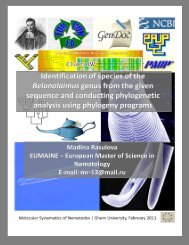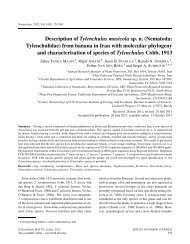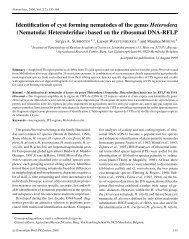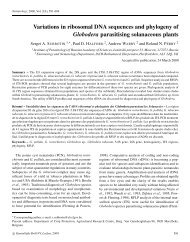You also want an ePaper? Increase the reach of your titles
YUMPU automatically turns print PDFs into web optimized ePapers that Google loves.
TreeView manual<br />
11/10/04 3:10 PM<br />
First release (68K Mac, PowerMac, Win16).<br />
Acknowledgments<br />
<strong>TREEVIEW</strong> is written in C++ and compiled with Borland C++ 5.01 (Windows), and Metrowerks CodeWarrior<br />
(Macintosh).Writing the interface to the program was made easier by using ideas from the National Center for<br />
Biotechnology's VIBRANT library written by Jonathon Kans and Julian Smart's wxWin C++ library.<br />
Implementing tabbed dialog boxes and other features was made easier by public domain code from Jim Stout (<br />
Jim's CDEFs), Edward McCreary (the TabDlg.DLL library) and Gilles Vollant (MRU library). The installation<br />
program for Windows 95 comes courtesy of InstallShield Corporation ; for Windows 3.1 I've used Freeman<br />
Installer. Code for drawing radial trees was adapted from J.-P. Barthélemy & G. Guénoche’s 1991 book Trees and<br />
proximity representations (John Wiley & Sons), with improvements based on Joe Felsenstein's "maximum<br />
daylight" algorithm ( Dave Swofford kindly gave access to his source code for this algorithm). Mike Charleston<br />
motivated me to complete the program, and helped with the window tiling algorithm for the Mac. I thank those<br />
users who reported bugs, made suggestions, and/or tested trial versions, especially Ralph Bernstein, Torsten<br />
Eriksson, Fred Rickson, Ed Rybicki, Tosak Seelenan, and Korbinian Strimmer.<br />
Appendix 1: Tree descriptions<br />
<strong>TREEVIEW</strong> reads trees written using variations of the "Newick 8:45" format adopted by the NEXUS format and<br />
by PHYLIP. This appendix gives a brief descrption of the format. To write a tree description visit all the nodes in<br />
the tree, starting at the root, and follow these rules:<br />
If the node is a leaf (= terminal taxon)<br />
Write the node's label, then return to the node's immediate ancestor. If the branch leading to the leaf has a length,<br />
write a colon then the length immediately after the leaf label, e.g "human:0.0167".<br />
If the node is an internal node:<br />
1. If you're visiting the node for the first time, write a left parenthesis "(", then visit the node's leftmost child.<br />
2. If you've already visited the node before, but haven't yet visited all that node's descendants, write a comma ",",<br />
then visit the next descendant of the node (going from left to right).<br />
3. If you've already visited the node before, and you've visited all the node's descendants, write a right parenthesis<br />
")". If the node has a label (e.g. a bootstrap value) then write that label now, e.g. ")100". If the branch leading to the<br />
node has a length, write a colon then the length immediately after the leaf label, e.g "):0.08".and visit the node's<br />
immediate ancestor (if any). If the current node is the root then terminate the description with a semicolon ";" and<br />
stop.<br />
A simple example<br />
Here is a simple tree and the sequence of steps used to describe it.<br />
http://taxonomy.zoology.gla.ac.uk/rod/treeview/treeview_manual.html#_Toc356614792<br />
Page 14 of 16
















